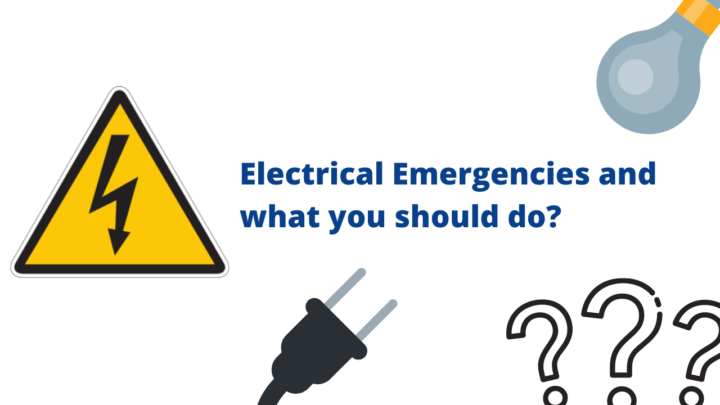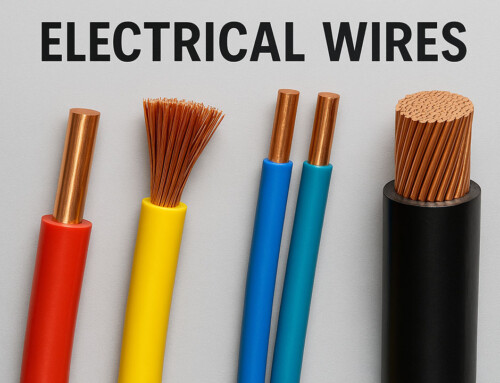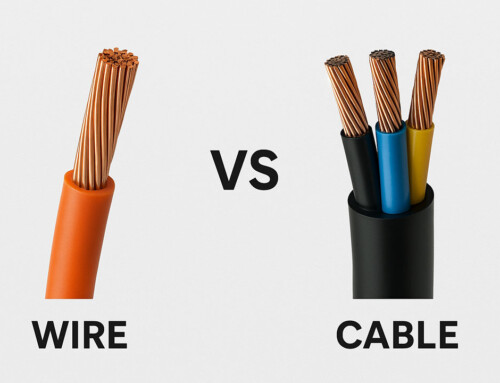Table of Contents
Electrical problems are usually minor, but the situations turn them into electrical emergencies. In such cases, it is essential to react immediately and smartly since an electrical emergency can pose severe risks to you and your family.
The 9 most common electrical emergencies are listed here, along with suggestions on what actions you should take when you face them.
What are Common Types of Electrical Emergencies?
Like most people, you probably don’t think about electrical emergencies until they happen. But knowing what to do in an electrical emergency can help keep you and your family safe. So invest your few minutes in reading this post to know everything. The 9 common electrical emergencies are:
-
Power outages
-
Electrical Fire
-
Electrical Shocks
-
Fallen power lines
-
Burnt Outlet
-
Short Circuits and Circuit Breaker Failure
-
Circuit Failure Due to Electrical Appliance Problem
-
Buzzing Sound From the Breaker Box
-
Frequently Tripping Breakers
Power Outage
Power outages are the most common emergency known as power failures or blackouts. Power outages can occur for various reasons, such as a downed power line, a storm, a shortage of energy, etc. It can be not only irritating but also hazardous. Hence, here are things you must do in case of a power outage:
- Turn Off the Main Power Source: Turn off the main power to all cooling and heating appliances powered by the circuit breaker. Make sure that you turn the branches off before the main circuit breaker. This way, you can ensure that all the appliances are protected when the power is turned off after the electrical emergency.
- Check the Source: Sometimes the power outage in your home could be due to a tripped circuit breaker. They often get tripped when an outlet is overloaded. So check for too many appliances plugged into a single outlet or extension. If that’s the case, remove the appliances and distribute the load once the power is back to keep the circuit breaker from tripping.
- Check for Damaged Wiring or Breaker: If the blackout isn’t due to a circuit overload, it may be due to faulty wiring. So, check the wiring for wear and tear. If that’s not the case, the outage may result from voltage fluctuations or some problem in the breaker itself. To be sure, call an electrician since resetting the circuit breaker without training could be difficult.
- Contact Your Distributor: When you’re sure the problem is on the distributor’s end, give them a call to check if they are doing something about the outage. Sometimes, the blackout can last for several hours. So, it’s better to be prepared.
- Reset Safely: When power returns, wait a few minutes before turning on your home appliances since the energy fluctuations can damage them. Make sure that you turn on the breaker first.
Electrical Fire
Electrical fires are caused by overloading, faulty or exposed wiring, or when flammable objects are placed near a light bulb. In case of an electrical fire, follow these 4 steps:
- Cut the Power Supply: The first thing to do in case of an electrical fire is to cut the power supply at the source. Flip the switch on your home’s circuit breaker box and cut the supply. This will stop the fire on time and reduce the risk of shocks if you are trying to put out the fire.
- Use a Fire Extinguisher to Put Out the Fire: In case of an electrical fire, you should only use a fire extinguisher rated Class-C. If the power supply has been cut, you can use a water-based fire extinguisher, Class A. Continue dispersing the chemical until the fire has been put out completely.
- Call the Fire Brigade Immediately: Call the fire brigade in case of electrical fires, even after you manage to put it out. Smoldering objects can still catch fire if you are unable to cut the power supply at the source.
- Evacuate the Site: If you cannot control the fire, exit the building immediately and call the local authorities. In case your clothes catch fire, stop, drop, and roll. Always stay close to the ground and avoid inhaling the smoke.
Electrical Shocks
When electrical wires are frayed, cords are damaged, or outlets go unchecked, contact with electricity happens. Take the following steps in case of an electrical shock:
- Turn off the Power Supply: When you become aware of the electrocution, turn off the power as quickly as possible. And if you are not close to the circuit, try and cut the contact between the electrical source and the person using an insulated item like a wooden rod or a PVC pipe.
- Don’t Touch the Person Who Received an Electric Shock: If someone is in direct contact with electricity, do not touch them under any circumstances. Stay calm and away.
- Call Your Local Emergency Service: Call 911 for help in case of an electrical hazard. Meanwhile, if you have received CPR or first aid training, administer it. And if you are not trained, the 911 operator will give you the necessary directions until the responder reaches.
- Unplug the Appliance Immediately: When a power outage occurs, turn off the branch circuits and the main breaker. This will cut off the power supply to all appliances and electronic devices and ensure electrical safety.
Fallen Power Lines
Fallen power lines pose a serious threat to life and property, so they should be dealt with extreme caution. If you are near a fallen power line, follow these 3 steps:
- Stay at Least 40 Feet Away: A fallen line may be alive even if it does not give off sounds, sparks, and lights. To avoid any mishap, maintain a distance of at least 40 feet from the power line. Also, check for any metal fences, fallen limbs, puddles, or vehicles that could act as conductive materials and pose an electrical hazard.
- Don’t Touch Any Object or Tree That is in Contact With the Fallen Power Line: Trees that are in contact with fallen power lines can be conductive. Even if you are unsure if the power line is live, avoid any contact with electrical materials touching the tree or surrounding it.
- Contact the Local Authorities Immediately: If you notice a dangling or downed power line, immediately bring it to the notice of your local power distributor of these power lines.
Burnt Outlet
Burnt outlets are one of the most common electrical emergencies. Overloaded circuits and old, outdated wiring are usually to blame. In the event of a power outage or other electrical emergency, there are a few steps you can take to ensure your safety. They are as follows:
- Unplug the Device Plugged in the Outlet: First, if you smell burning plastic or see sparks from an outlet, immediately unplug any devices plugged into it and do not touch the outlet.
- Turn Off the Power: If you can safely do so, turn off the power to that area of your home at the breaker box.
- Call a Professional: Once everything is turned off and unplugged, call a qualified electrician to inspect the outlet and make any necessary repairs.
- Treat Your Injury: If you experience a minor burn from an electrical source, such as a shock from an outlet, run cool water over the area for several minutes. Apply aloe vera gel or another soothing agent if needed. If the burn is more serious, or if you have any doubts about your ability to treat it properly, seek medical attention immediately.
Short Circuits and Circuit Breaker Failure
Your home’s electrical system comprises many different circuits, each with its circuit breaker. These breakers are designed to trip or shut off in the event of an electrical emergency, such as a power surge or overload.
However, circuit breakers can sometimes fail. If this happens, it can cause a short circuit, which can be dangerous because it can cause sparks and electrical shocks. It can also start fires. Here’s what you need to know about short circuits and circuit breaker failure:
- Unplug Devices & Switch Off Power: This is a constant practice in all types of electrical emergencies. The same is the case with a short circuit. The first thing you should do is unplug all of your appliances and electronics. Then, turn off the power at your fuse box or circuit breaker. You might get the power back by unplugging some of the devices if overload was an issue.
- Call Utility Company: You’ll want to call your utility company to have them come and take a look at the situation in case of a circuit breaker failure.
- Fix the Loose Connection: Once the power is off, you can inspect your wiring to see if there is a loose connection or a bare wire. If you find a loose connection, you can tighten it with a screwdriver. If you find a bare wire, you should cover it with electrical tape.
- Call for Help: If you are unsure how to fix a short circuit, you should call an electrician. They can safely repair your wiring and prevent any further damage. In the meantime, you can use battery-operated lights and appliances. And, if you have a generator, you can use it to power your home until the electricity is back on.
Circuit Failure Due to Electrical Appliance Problem
Does it happen to you that your circuit trips when you plug an appliance? It can be frustrating if it keeps happening repeatedly. There could be 2 possible scenarios – Either there is a problem in your electrical system, or your appliance is faulty. Let’s see what you can do in either of them.
- Electrical System Problem: Call an expert to check that the circuit breaker installed in your house or factory is well equipped to take the load of your appliances or not. An electrician can also inspect the entire electrical wiring system of your home. If they found nothing, your appliance is probably the issue.
- Contact the Manufacturing Company: If your appliance is faulty, you must contact the manufacturing company. They can replace it if it’s under warranty or repair it.
Buzzing Sound From the Breaker Box
If you hear a buzzing sound coming from your breaker box, it’s time to call an electrician. This is not a do-it-yourself project. The problem may be with a circuit breaker that needs to be replaced. Or, there could be loose wiring causing the problem.
Either way, it’s best to let a professional handle it. If you ignore the problem, it could lead to an electrical fire. So don’t delay calling an electrician if you hear that tell-tale buzzing sound coming from your breaker box.
Frequently Tripping Breakers
If your home’s electrical system is constantly tripping breakers, it’s a sign of an electrical emergency. There are several possible reasons for circuit breaker tripping, like circuit overload or faulty wiring. Here’s what you should do:
- Check for Damage: Check for noticeable signs of damage to your home’s electrical system, like exposed wiring or sparks. If you see any damage, call an electrician right away.
- Identify Tripping Breaker: Try to identify which breaker is tripping and reset it. If the breaker trips again, call an electrician to diagnose the problem.
- Call for Troubleshooting: If you can’t identify the problem or reset the breaker, turn off all power to your home at the main breaker and call an electrician immediately.
To ensure electrical safety at home, cover all the outlets with surge protectors and install safety switches to monitor the flow of current. Hire an electrician for installations and repairs to prevent electrical hazards.
At D & F Liquidator, we stock a vast inventory of electrical materials and safety supplies that minimize the risk of electrical hazards. Call (800) 458-9600 to connect with our sales professionals.






